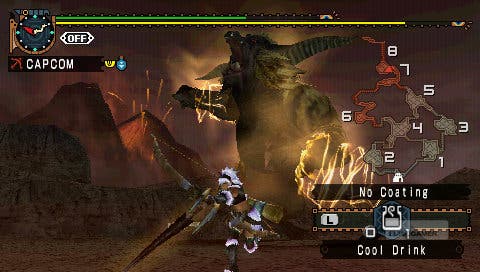Monster Hunter Freedom Unite
Stalking point.
I've done it. After 70 hours, six weeks, dozens of missions and a great deal of inventive invective I've finally made my mark on Monster Hunter. I'm now Hunter Rank 2. Yes, two. And no, it's not an inverted rank table - two is actually the second level, the first rung on the vertical learning ladder.
It seems pathetic, now I have it in front of me in black and white, but I'm feeling tremendously proud. There have been so many crushing defeats over the last month and a bit, so many unceremonious spankings, roastings and straight-up surprise sexings, that I feel like I've earned that extra tiny star next to my name on the Guild Card with my very own blood, sweat and tears.
It's not been wall-to-wall fun - there have been plenty of fist-clenching moments of pure, frustrated rage - but I've thoroughly enjoyed it. I'm not a patient person but, oddly, the catharsis of Monster Hunter Freedom Unite's insanely sadistic learning curve has granted me a Zen-like calm. Turns out that patience isn't just a virtue, it's a lesson well worth learning.
Even newcomers to the series will have some idea what's going on. On a simplistic level, the title says it all. You're here to hunt monsters: giant, epic, titanic bastard monsters who'll routinely knock seven shades out of you unless you know what you're doing. But the subtleties of the task in hand quickly multiply like some kind of Byzantine, fractal wedding plan.
There's a gruffly narcissistic trainer who'll school new players in the basic arts of grim butchery. The long tutorial process ensues will stand you in good stead if you can endure the repetition. It's basically an extended introduction to each of the 11 weapon classes, giving rookies the chance to familiarise themselves with the specific pros and cons of each.

These weapon types essentially take the place of classes, each dictating different tactical approaches and abilities. Pick up a lance, for example, and you'll be in a tanking role - with boosted defensive capabilities coming at the cost of a limited range of attacks. Great Swords and hammers offer the greatest offensive value, but their swings are heavy and cumbersome, with mistimed smashes leaving you extremely vulnerable to punishing counter-attacks. Bows and bowguns offer ranged capabilities and status attacks with specific ammo types, but crowd management and melee vulnerability become important issues. Mastering each class isn't necessary, but a passing skill with each is certainly a great boon - many monsters' tactics will render certain weapons all but unusable.
Heading out into the wilderness for the first time feels like an epic undertaking. Delving into the blue supply box just outside your tent reveals the tip of the complexity iceberg - besides the usual map and health potions are stacked items for sharpening your weapons, drinks to regulate your temperature, rations to maintain stamina, ammo types, arrow coatings, antifreeze solutions, tranquillisers and electrical traps. For the beginner, it's overwhelming, but in actual fact, this is a tiny, tiny sliver of the options available. Over the course of this massive game you could be dealing with over 1500 weapons, 2000 armour sets and god only knows how many different items and crafting materials in 400 different missions.

Most missions directly involve killing things. Usually, hunters will be assigned the task of heading out to exterminate a single 'boss' beast, or Wyvern, or a pack of smaller creatures. Planning each excursion is the key to success. Picking the right equipment, preparing yourself to counter the dangers of foes and environment, will be the delineating line between those who succeed and those who rage-quit in surly frustration. Some of the more common items may be bought from village traders, but most materials are gathered from points in the field - from ore veins, dung piles, plants, streams and corpses.









